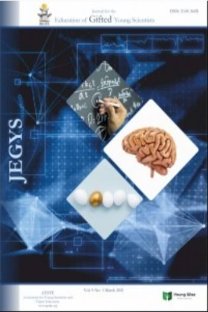Misconception Analysis of Junior High School Student in Interpreting Fraction
Interpretation of fraction is the basis of meaningful fraction learning. Students' misconceptions in interpreting fractions can be obstacles for students to understand further mathematical concepts. The purpose of this study is to identify students' misconceptions in interpreting fractions. This research usedcontent analysismethode. The participants of this study were 63 students (32 female, 31 male) in one junior high school in Bengkulu City, Indonesia. This research participant has just studied the topic of fractions. Data collection was carried out by giving tests to 63 participants, and interviews with 6 students to obtain more comprehensive information. The questions asked in interview are based on students' answers on the previous test. The selection of students interviewed was done by purposive sampling. The results showed that students experienced misconceptions in interpreting fractions as part of whole, as quotient, as ratios, as operators, and as measures. Based on the results of the interview, the misconception occurred because students experienced limited context in recognizing fractions.
Keywords:
misconception, fraction, part of whole quotient, ratio, measure,
___
- Bailey, D. H., Siegler, R. S., & Geary, D. C. (2014). Early predictors of middle school fraction knowledge. Developmental Science, 17(5), 775–785. https://doi.org/10.1111/desc.12155
- Chapin, S. H., & Johnson, A. (2006). Math Matters: Understanding The Math You Teach Grade K-8 (Second Edition). Math Solution Publication.
- Charalambous, C. Y., & Pitta-Pantazi, D. (2005). Revisiting A Theoretical Model On Fractions: Implications for Teaching and Research. Proceedings of the 29th Conference of the International Group for the Psychology of Mathematics Education, 233–240.
- Charalambous, C. Y., & Pitta-Pantazi, D. (2007). Drawing On A Theoretical Model to Study Students’ Understanding of Fractions. Educational Studies in Mathematics, 64(3), 293–316.
- Doyle, K. M. (2016). The Rational Number Sub-Constructs as a Foundation for Problem Solving. Problem Solving, 11, 22.
- Ghani, S. N. A., & Maat, S. M. (2018). Misconception of Fraction among Middle Grade Year Four Pupils at Primary School. 2(1), 15.
- Huda, S., Sholikhakh, R. A., Bina, N. S., Lestari, F., Habibi, B., & Suharso, P. (2019). Effect of Application Smart Circuit Learning Media to Mathematics Learning Outcomes: A Case Study of Junior High School Students. Journal for the Education of Gifted Young Scientists, 7(3), 745–761. https://doi.org/10.17478/jegys.597053
- Jannah, A. F., & Prahmana, R. C. I. (2019). Learning Fraction using the Context of Pipettes for Seventh-Grade Deaf-Mute Student. Journal for the Education of Gifted Young Scientists, 7(2), 299–321. https://doi.org/10.17478/jegys.576234
- Kolar, V. M., Hodnik Čadež, T., & Vula, E. (2018). Primary Teacher Students’ Understanding of Fraction Representational Knowledge in Slovenia and Kosovo. Center for Educational Policy Studies Journal, 8(2), 71. https://doi.org/10.26529/cepsj.342
- Lamon, S. (2012). Teaching fractions and ratios for understanding. New York : Taylor & Francis. Lazić, B., Abramovich, S., Mrđa, M., & Romano, D. A. (2017). On the Teaching and Learning of Fractions through a Conceptual Generalization Approach. 12 (3), 749–767.
- Makonye, J. P., & Fakude, J. (2016). A Study of Errors and Misconceptions in the Learning of Addition and Subtraction of Directed Numbers in Grade 8. SAGE Open, 6(4), 215824401667137. https://doi.org/10.1177/2158244016671375
- Mamede, E., Nunes, T., & Bryant, P. (2005). The Equivalence and Ordering of Fraction in Part-Whole and Quotient Situation. Proceedings of the 29th Conference of the International Group for the Psychology of Mathematics Education, Vol. 3, Pp. 281-288. Melbourne: PME.
- Mohyuddin, R. G., & Khalil, U. (2016). Misconceptions of Students in Learning Mathematics at Primary Level. Bulletin of Education and Research, 38(1), 133–162.
- Naiser, E. A., Wright, W. E., & Capraro, R. M. (2003). Teaching Fractions: Strategies Used for Teaching Fractions to Middle Grades Students. Journal of Research in Childhood Education, 18(3), 193–198. https://doi.org/10.1080/02568540409595034
- Nakamura, A. (2014). Hierarchy Construction of Mathematical Knowledge. Lecture Notes on Information Theory. https://doi.org/10.12720/lnit.2.2.203-207
- Ojose, B. (2015). Students’ Misconceptions in Mathematics: Analysis of Remedies and What Research Says. 72(72), 5.
- Resnick, I., Jordan, N. C., Hansen, N., Rajan, V., Rodrigues, J., Siegler, R. S., & Fuchs, L. S. (2016). Developmental growth trajectories in understanding of fraction magnitude from fourth through sixth grade. Developmental Psychology, 52(5), 746–757. https://doi.org/10.1037/dev0000102
- Sarwadi, H. R. H., & Shahrill, M. (2014). Understanding Students’ Mathematical Errors and Misconceptions: The Case of Year 11 Repeating Students. Mathematics Education Trends and Research, 2014, 1–10. https://doi.org/10.5899/2014/metr-00051
- Siegler, R. S., Duncan, G. J., Davis-Kean, P. E., Duckworth, K., Claessens, A., Engel, M., Chen, M. (2012). Early Predictors of High School Mathematics Achievement. Psychological Science, 23(7), 691–697. https://doi.org/10.1177/0956797612440101
- Simon, M. A., Placa, N., Avitzur, A., & Kara, M. (2018). Promoting a concept of fraction-as-measure: A study of the Learning Through Activity research program. The Journal of Mathematical Behavior, 52, 122–133. https://doi.org/10.1016/j.jmathb.2018.03.004
- Wijaya, A. (2017). The Relationships between Indonesian Fourth Graders’ Difficulties in Fractions and the Opportunity to Learn Fractions: A Snapshot of TIMSS Results. International Journal of Instruction, 10(4), 221–236. https://doi.org/10.12973/iji.2017.10413a
- Başlangıç: 2013
- Yayıncı: Genç Bilge Yayıncılık
Sayıdaki Diğer Makaleler
Pardimin PARDİMİN, Nyoman ARCANA, Didi SUPRİADİ
Rosdiana ROSDİANA, İ Ketut BUDAYASA, Agung LUKİTO
Munifah ., İskandar TSANİ, Muhamad YASİN, Ninik ZUROİDAH, Syamsul HUDA, Fitria LESTARİ, Ali RAHMAT
Oranit CHOKCHAİ, Paitoon PİMDEE
Abdulloh HAMID, Punaji SETYOSARİ, Saida ULFA, Dedi KUSWANDİ
Gunawan GUNAWAN, Ahmad HARJONO, Lovy HERAYANTİ, Sadam HUSEİN
Fitri ARSİH, Siti ZUBAİDAH, Hadi SUWONO, Abdul GOFUR
